Lime Swallowtail Pest Profile
Pest Profile
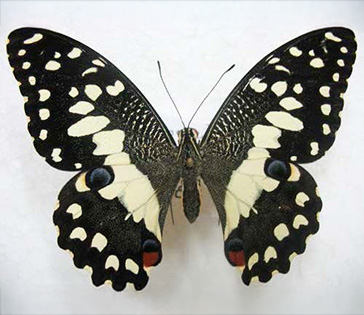
Description
Papilio demoleus is a large butterfly with a wingspan of up to 10 cm. The forewings (upper wings) are mostly black with irregular yellow spots on the outer wing margins. The hindwings (lower wings) have a distinctive red spot with blue scales and a discal black band with yellow scales. The underside is a paler yellow with black sections containing more yellow than the upper side of the wings. It does not have the “tails” that extend from the hindwings of most swallowtail butterflies. Lime swallowtail eggs are laid on the surface of tender leaves and twigs and are creamy yellow in appearance, spherical, and flattened at the base. Larvae in the first four instars have a distinct V-shaped white mark that extends from the anterior to the posterior as well as a series of short fleshy spines on the front sides and thorax. Larvae in these early stages have a black head and resemble a bird dropping in appearance. As larvae grow into their fifth instar, they become more cylinder-shaped, their spines change from a yellow-orange hue to green, and the body overall becomes predominantly green to yellowish-green in color.
Photos: http://entnemdept.ufl.edu/creatures/bfly/lime_swallowtail.htm
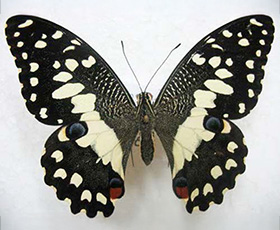
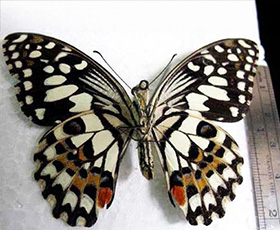
Photo credits: All pictures taken by Dr. Mark Hoodle, Director at the Center for Invasive Species Research (CISR) at UC Riverside
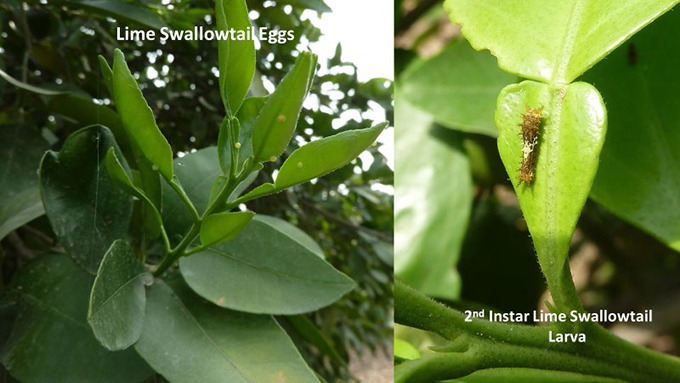
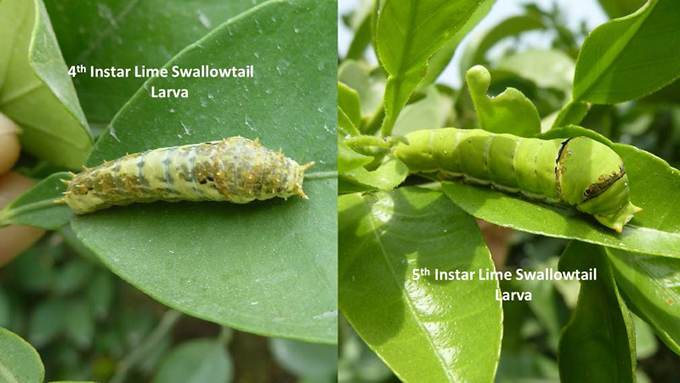
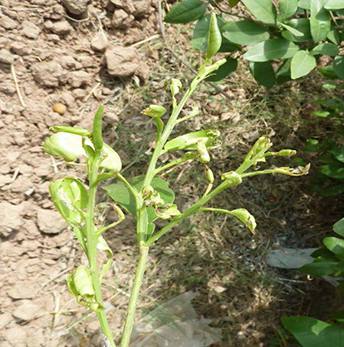
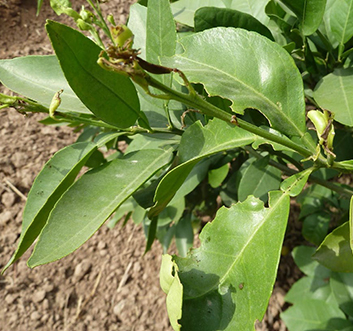
History
Papilio demoleus was first found in the Dominican Republic in March 2004 and had spread to Puerto Rico in 2006. There are no official detections of this species in California, however an unofficial specimen was collected in August 2020 in Los Angeles County. Two other reports of P. demoleus were submitted through the citizen science website, iNaturalist in the same year, one from Los Angeles County and the other in San Luis Obispo County. The lime swallowtail is a strong flier and therefore can spread into some regions of California if left unchecked.
Distribution
Papilio demoleus is native to the subtropical and tropical areas of southern Asia, ranging from the Middle East to India and southern China to Japan. Subspecies of P. demoleus are also found in Malaysia, New Guinea, and Australia. Recently, lime swallowtail has found its way into North America, having been recorded in the Dominican Republic, Puerto Rico, and Jamaica.
Life Cycle
Papilio demoleus eggs are laid singly on the leaves of a host plant. The larval stage includes five instars, with the first four instars having a similar body coloration. Early instar larvae have the appearance of bird droppings which is used as a defensive camouflage to protect themselves from being eaten by predators. In the fifth instar, larvae become predominantly green. The pupae vary from a green to straw-brown color. In laboratory environments, adults emerged from their pupae around 24 to 26 days after eggs were laid, with female adults tending to live longer than males. The development of P. demoleus is more rapid at higher temperatures. In Puerto Rico, the time required to complete a life cycle is reported to be approximately 30 days and 12 generations may be possible per year. Fewer generations are reported in milder climates.
Host(s) and Economic Impact
The subspecies of P. demoleus that originate from southeastern Asia feed primarily on citrus (including Citrus, Murraya, and Aegle species) and are considered serious pests of citrus trees. Two subspecies that occur in Australia and New Guinea feed mainly on Cullen species (Fabaceae), and plants in several additional families are reported to be hosts as well. Papilio demoleus consumes the foliage of citrus trees and the larvae can seriously damage host trees because they devour large quantities of foliage. This is of special concern to citrus nursery stock as young citrus trees are most severely affected by larval feeding. Severe infestation causes tree defoliation and can even lead to growth retardation and decreased fruit yields.
References
- Eastwood, R., Boyce, S. L., and Farrell, B. D. 2006. The provenance of Old World swallowtail butterflies, Papilio demoleus (Lepidoptera: Papilionidae), recently discovered in the New World. Annals of the Entomological Society of America 99:164-168.
- Heppner, John B. 2006 “Lime Swallowtail in the Caribbean and Possible Impacts for Florida Citrus” Florida Department of Agriculture and Consumer Services, Division of Plant Industry December 2006
- iNaturalist. Accessed April 15, 2021: https://www.inaturalist.org/
- Jahnavi et al., 2018 “Biology and morphology of citrus butterfly Papilio demoleus Linnaeus (Lepidoptera:Papilionidae) on acid lime” Journal of Entomology and Zoology Studies. 2018
- Lewis, Delano S. 2018 Lime Swallowtail Papilio demoleus Linnaeus (Insecta:Lepidoptera: Papilionidae) University of Florida. Department of Entomology and Nematology UF/IFAS Extension 2018
- Minh, H. G., Giang, H. T. T., and Trang, H. T. Q. 2015. Studies on some aspects of the biology and ecology of citrus butterfly Papilio demoleus (Papilionidae: Lepidoptera) on citrus in Vietnam. Journal of Tropical Asian Entomology 4:20-27.
- Segarra-Carmona, A. E., Cabrera-Asencio, I., Flores-López, L. E., and Morales-Collado, L. 2010. Ciclo de vida y control de la mariposa asiática de los cítricos, Papilio demoleus (Lepidoptera: Papilionidae), una nueva plaga invasive en Puerto Rico. The Journal of Agriculture of the University of Puerto Rico 94:165-174.
